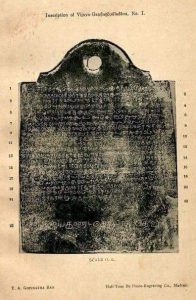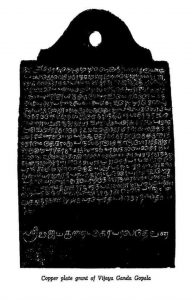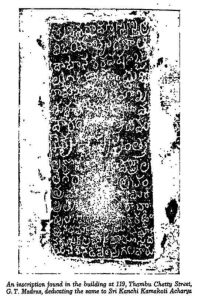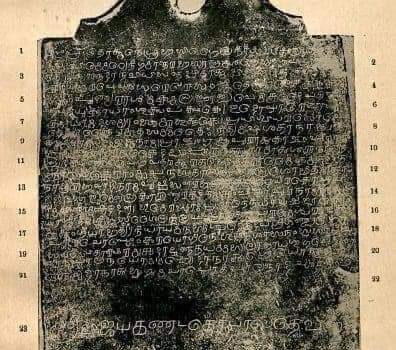
Copper plates and epigraphic evidences!



(Credits: Prof Dr. Sankara Narayanan G)
Shri Kanchi Kamakoti Pitham – Epigraphic Evidences
Kanchi Kamakoti Pitham is the Moolamnaya pitham in Kanchipuram. In 1816, Colonel Mackenzie was documenting various inscriptions, and sent his assistant Babu Rao to the Kanchi Kamakoti Pitham.
He mentions that on 10th April 1817, when he saw the matham and enquired about the inscriptions, he saw the Chola and Pandya copper Plate inscriptions and that he took a copy of two inscriptions.
However in 1916, as per the ajna of Mahasvamigal, when epigraphy expert Shri. T. A. Gopinatha Rao searched for the inscriptions, he was able to find only the copper plate inscriptions beginning with the times of Telugu Chola Vijayagandagopala. Gopinatha Rao mentions that the others were lost. Half of an inscription was found later from one of the tanks where Mahaswamigal used to take a bath.
Ten copper plate inscriptions are in the Shrimatham. These and some inscriptions on stone, show the antiquity of the matham as clear as crystal.
1. Vijayaganda Gopala Deva’s Ambikapuram Inscription 1231 CE
This was by the Telugu Chola Vijayaganda Gopala Deva. This copper plate inscription serves as evidence for the offering of the village of Keezhambi to Shankaracharya. The date of this copper plate inscription
is 1231 CE.
2. Kumara Kampanna’s Kanchimatham Stone Inscriptions -14th CE
In the last quarter of the fourteenth century, Kumara Kampanna rescued Tamilnadu from the clutches of invaders. His stone inscription is on the walls of the Shrimatham in segments.
The usage of the term “Mathappuram” can also be seen. Mathappuram is the grant of land given to mathas.
3. Vira Narasimha’s Ezhuchur Copper Plate Inscription 1507 CE
Vijayanagara King Viranarasimha’s copper plate was granted by him on the banks of Tungabhadra. It was given in Saka Year 1429 ie 1507 CE, to the Shankaracharya Swami Sadashiva Sarasvati whose body is radiant with the application of Vibhuti and His benevolence and grace shining with the rudraksha on His neck.
4. Vira Narasimha’s Gudiyantandalam Copper Plate Inscription 1507 CE
The same king granted the village of Gudiyantandalam to Sadashiva Saraswati.
5. Krishnadeva Raya’s Kizhambi Stone Inscription – 1514 CE
This stone inscription from the time of Krishna Deva Raya, documents the granting of the mathappuram Ambikapuram ie Keezhambi by Chandrashekhara Saraswati Swamigal as a danam to the temple of Ambikavana nayanar is found on the walls of that temple
6. Krishnadeva Raya’s Podavur Copper Plate Inscription – CE 1522
This copper plate inscription documents the granting of the two towns of Podavur and Kattuppakkam, combined together with the name Krishnadevaraya puram to Chandrachuda Saraswati Swamigal of Kanchipuram, the disciple of Mahadeva Saraswati.
7. Krishnadeva Raya’s Udayampakkam Copper Plate Inscription – CE 1528
This copper plate inscription documents the granting of the town of Udayambakkam to Sadasiva Saraswati, the very form of Shiva Himself (mentioned before) and who was the disciple of Chandrashekhara Saraswati
by Krishna Deva Raya from the banks of the River Tungabhadra.
8. Sadasiva Raya’s Varadarajaswami temple Stone Inscription – CE 1562
This stone inscription refers to the place Suruttil adjacent to Gudiyantandalam mentioned before, as Shankaracharyapuram
9. Incomplete Vijayanagara Copper Plate Inscription
This copper plate inscription from the 16th century is incomplete and also does not mention the name of the king.
10. Vijayaraghunatha Tondaiman – CE 1691
This copper plate inscription explains the manyam given to Venkata Krishnaiyer Ulattu (of the Matham) by the Pudukkottai King Vijaya Raghunatha Tondaiman.
11. Vijayaranga Chokkanatha’s Jambukeshvaram Copper Plate Inscription – CE 1708
This copper plate inscription documents the granting of places such as Mahendramangalam to Shankaracharya of Kanchipuram.
12. Golconda Sultan’s Melupaka Copper Plate Inscription – CE 1686
This copper plate inscription records the grant of Melpakkam to Kamakoti Pitdhadipati by Golconda Sultan. It is noteworthy that the birudavali of the Shrimatham is found in full here.
13. Mahadevendra Saraswati’s Melupaka Copper Plate Inscription CE 1687
This copper plate inscription refers to the dana given to Rama Shastri during a grahana kalam by Kamakoti Pithadipati Mahadevendra Saraswati. Here too , the birudavali of the
Matham can be seen.
14. Thambu Chetty Street Stone Inscription – CE 1742
A stone inscription in Thambu Chetty Street, Chennai describes the building of a matham for Shankaracharya Swamigal.
In addition to these, from the beginning of the 18th Century, there are several documentary evidences in the Shrimatham in the form of correspondences and other documents with various mathams, kings, East India Company. Along with these, the stone inscription of Vira Rajendran in Chozhamadevi, that refers to the varttika of Chidananda Bhatarar on Bhagavatpadiyam Shariraka Bhashyam, is considered to refer to the Kamakoti Pithadipati, Acharya Chidghana by Dr. Nagaswami and other scholars.
Among the vaidika mathas of India that are still alive today, this is the only matham that has a continuity of inscriptional evidences over the last 800 years.
The impartial researchers and historians of Tamilnadu must consider this Matham as one of the historical treasures due to the antiquity and the historical continuity. The objectivity and interest in history of those who speak about this with scorn are questionable.
Jaya Jaya Shankara 🙏
Hara Hara Shankara 🙏

